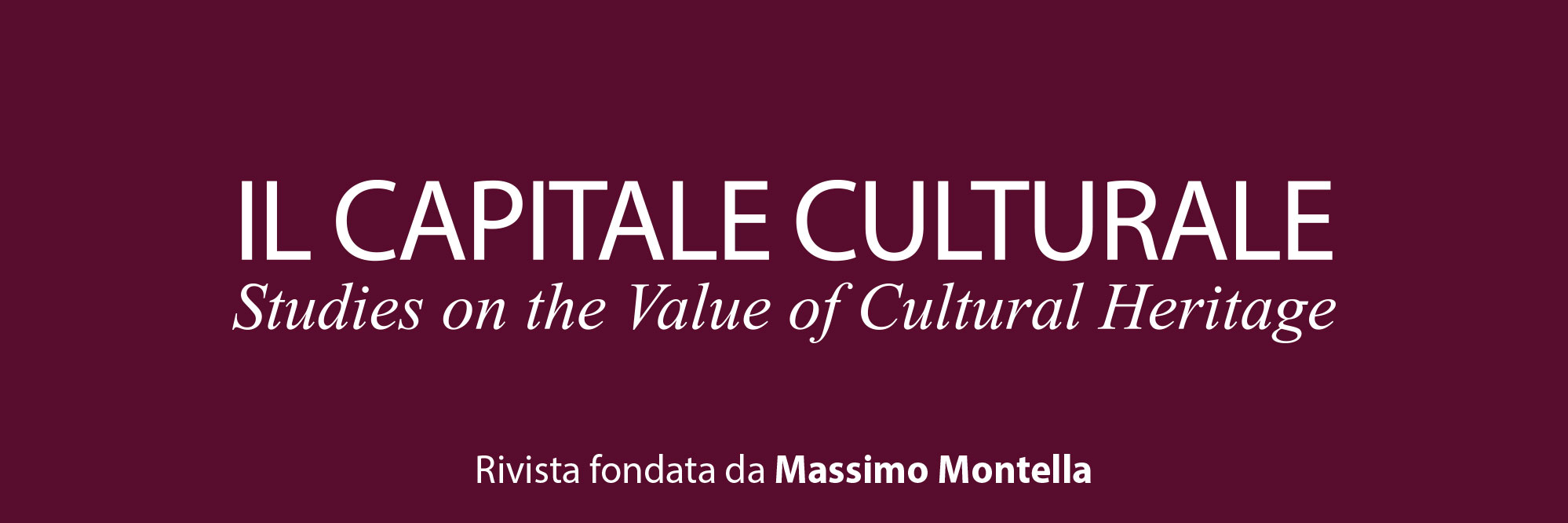Quando il museo comunica l’impresa: identità organizzativa e sensemaking nel museo Salvatore Ferragamo / When the museum communicates the company: organizational identity and sensemaking in Salvatore Ferragamo museum
Downloads
Pubblicato
Fascicolo
Sezione
Licenza
Tutti i materiali pubblicati sono coperti da copyright, mantenuto dall'Università di Macerata che ne supporta finanziariamente e tecnicamente la pubblicazione.
La licenza adottata è la Creative Commons - Attribuzione/Condividi allo stesso modo. Ovvero, gli autori che pubblicano su questa rivista accettano le seguenti condizioni:
- Gli autori mantengono i diritti sulla loro opera e cedono alla rivista il diritto di prima pubblicazione dell'opera, contemporaneamente licenziata sotto una Licenza Creative Commons - Attribuzione che permette ad altri di condividere l'opera indicando la paternità intellettuale e la prima pubblicazione su questa rivista.
- Gli autori possono aderire ad altri accordi di licenza non esclusiva per la distribuzione della versione dell'opera pubblicata (es. depositarla in un archivio istituzionale o pubblicarla in una monografia), a patto di indicare che la prima pubblicazione è avvenuta su questa rivista.
- Gli autori possono diffondere la loro opera online (es. in repository istituzionali o nel loro sito web) prima e durante il processo di submission, poiché può portare a scambi produttivi e aumentare le citazioni dell'opera pubblicata.
DOI:
https://doi.org/10.13138/2039-2362/1358Abstract
I musei d’impresa rappresentano una forma di memoria organizzativa che può e deve essere usata in maniera consapevole per lo sviluppo e la comunicazione dell’identità e dell’immagine dell’impresa. Oggetto del lavoro è l’analisi del ruolo strategico che il museo può assumere come strumento di narrazione dell’identità d’impresa. Il framework teorico è basato sui costrutti dell’identità organizzativa e del sensemaking nonché sul paradigma narrativo. In particolare, l’indagine esplorativa chiarisce la natura e il contenuto dell’identità organizzativa della Ferragamo SpA, considerando il museo d’impresa come asset in grado di comunicare ed esaltare i valori identitari dell’impresa. Ferragamo rappresenta un exemplum di come un’impresa heritage-based possa adoperare la storia nella “narrazione” allo scopo di dialogare con i suoi stakeholders esterni e interni rafforzando autenticità e credibilità nel marchio.
The paper assumes that corporate museums are a form of organizational memory to be strategically used for the development and the communication of a company’s identity and image. Object of the work is the analysis of corporate museum’s strategic role in telling the company. The theoretical framework is based on organizational identity and sensemaking topics together with the narrative paradigm. The exploratory study clarifies the organizational identity nature of the Ferragamo SpA, considering the corporate museum as an asset communicating what is core about the company. Ferragamo can be considered as an exemplum of how a heritage based company can manage the story in “narrative” in order to communicate to its external and internal stakeholders reinforcing the authenticity and the credibility of the brand.
Riferimenti bibliografici
Albert S., Ashforth B.E., Dutton J.E. (2000), Organizational Identity and Identification: Charting New Waters and Building New Bridges, «Academy of Management Review», 25, n. 1, pp. 13-17.
Amari M. (1997), I musei delle aziende. La cultura della tecnica tra arte e storia, Milano: Franco Angeli.
Barney J.B., Bandson S., Foremen P., Gustafson L.T., Huff A.S., Martins L.L., Reger R.K., Sarason Y., Stimpert J.L. (1998), A Strategy Conversation on the Topic of Organization Identity, in Identity in Organizations: Building Theory through Conversations, edited by D.A. Whetten, P.C. Godfrey, Thousand Oaks, CA: Sage, pp. 99-168.
Blumer H. (1969), Symbolic interactionism: Perspective and Method, Englwood Cliffs, NJ: Prentice-Hall.
Bonti M. (2012), I musei d’impresa e la valorizzazione del territorio, in Le imprese nel rilancio competitivo del Made e Service in Italy: settori a confronto, a cura di C. Ciappei, G. Padroni, Milano: FrancoAngeli, pp. 300-333.
Boyce M. (1995), Collective centring and collective sense-making in stories, «Organization Studies», 16, n. 1, November, special edition, pp. 141-150.
Bossaglia R. (1997), Prefazione a M. Amari, I musei delle aziende, Milano: Franco Angeli, pp. 5-8.
Burrel G., Morgan G. (1979), Sociological paradigms and organizational analysis, London: Heinemann Educational Books.
Castellani P., Rossato C. (2014), On the communication value of the company museum and archives, «Journal of Communication Management», 18, n. 3, pp. 240-253.
Corley K.G., Harquail M.G., Pratt M., Glynn C.M., Hatch M.J. (2006), Guiding Organizational Identity through Aged Adolescence, «Journal of Management Inquiry», n. 15, pp. 85-99.
Cornelissen J.P., Haslam S.A., Balmer J.M.T. (2007), Social Identity, Organizational Identity and Corporate Identity: Towards an Integrated Understanding of Processes, Patternings and Products, «British Journal of Management», n. 18 (special issue), pp. 1-16.
Czarniawska B. (1997), Narrating the organization: Dramas of institutionalized identity, Chicago: University of Chicago Press.
Danilov V. (1992), A planning guide for corporate museums, galleries, and visitor centers, Westport, CT: Greenwood Press.
Denzin N.K., Lincoln, Y.S. (1994), Introduction: Entering the field of qualitative research, in Handbook of qualitative research, edited by N.K. Denzin, Y.S. Lincoln, Thousand Oaks, CA: Sage, pp. 248-261.
Fink A., Kosecoff J. (1985), How to Conduct Surveys: A Step-by-step Guide, Beverly Hills, CA: Sage.
Fisher W.R. (1984), Narration as human communication paradigm: The case of public moral argument, «Communication Monographs», n. 51, pp. 1-22.
Fisher W.R. (1987), Human communication as narration: toward a philosophy of reason, value and action, Columbia, SC: University of South Carolina Press.
Fiske S., Tylor S. (1991), Social Cognition, New York: McGraw-Hill, Inc.
Follet M.P. (1924), Creative experience, New York: Longmans, Green.
Fontana A. (2013), Manuale di Storytelling: Raccontare con efficacia prodotti, marchi e identità d’impresa, Milano: Etas.
Fowler F.J. (1993), Survey Research Methods, 2nd ed., Newbury Park, CA: Sage.
Gabriel Y. (2000), Storytelling in organizations: Facts, fictions and fantasies, Oxford, UK: Oxford University Press.
Gilodi C. (2002), Il Museo d’Impresa: forma esclusiva per il Corporate Marketing, Liuc Papers n. 101, Serie Economia aziendale 10, marzo, pp.1-37.
Gioia D.A. (1998), From individual to Organizational Identity, in Identity in Organizations. Building Theory Through Conversations, edited by D.A.
Whetten, P.C. Godfrey, Thousand Oaks, CA: Sage, pp. 17-31.
Gioia D.A., Chittipeddi K. (1991), Sensemaking and Sensegiving in Strategic Change Initiation, «Strategic Management Journal», 12, n. 6, pp. 433-448.
Gioia D.A., Schultz M., Corley K.G. (2000a), Organizational identity, image, and adaptive instability, «The Academy of Management Review», 25, n. 1, pp. 63-81.
Gioia D.A., Schultz M., Corley K.G. (2000b), Where do we go from here?, «The Academy of Management Review», 25, n. 1, pp. 145-147.
Gioia D.A., Thomas J.B. (1996), Identity, Image and issue interpretation: Sensemaking during strategic change in academia, «Administrative Science Quarterly», n. 41, pp. 370-403.
Gustafson L.T., Reger R.K. (1995), Using organizational identity to achieve stability and change in high velocity environment, «Academy of Management Best Papers Proceedings», n. 1, August, pp. 464-468.
Hansen C.D., Kahnweiller W.M. (1993), Storytelling: an instrument for understanding the dynamics of corporate relationship, «Human Relations», 55, n. 8, pp. 989-1010.
Haslam S.A., Ellemers N. (2005), Social Identity in Industrial and Organizational Psychology: Concepts, Controversies and Contributions, «International Review of Industrial and Organizational Psychology», n. 20, pp. 39-118.
Hatch M.J., Schultz M. (1997), Relations between organizational culture, identity and image, «Journal of Marketing», n. 31, pp. 356-365.
Herdan G. (1964), Quantitative linguistics, London: Butterworth & Co. Pubblishers.
Il Calzolaio dei Sogni (2010), Autobiografi a di Salvatore Ferragamo, Milano: Skira.
Kavanagh G. (1999), Making Histories, Making Memories, in Making Histories in Museums, edited by G.
Kavanagh, London: Leicester University Press, pp. 1-14.
Kinni T. (1999), With an eye to the past: Transmitting the corporate memory, «Corporate University Review», 7, n. 1, pp. 24-27.
Kransdorff A., Williams R. (2000), Managing organizational memory (OM): The new competitive advantage, «Organization Development Journal», 18, n. 1, pp. 107-117.
Lalli P. (2003), Musei d’impresa memoria del futuro, «L’impresa», n. 5, pp. 78-85.
Lambin J.J. (2000), Marketing strategico, Milano: MacGraw Hill.
Lane J.B. (1993), Oral History and Industrial Heritage Museums, «The Journal of American History», n. 80, pp. 607-618.
Lavrakas P.J. (1993), Telephone Survey Methods: Sampling, Selection, and Supervision, Newbury Park, CA: Sage Livingstone.
Linde C. (1993), Life Stories: The Creation of Coherence, New York: Oxford University Press.
Livingstone P. (2011), Is it a museum an experience? Corporate exhibitions for corporate tourists, «Exibitionist», Spring, pp. 16-21.
Margolis S.L., Hansen C.D. (2002), A model for organizational identity: Exploring a path to sustainability during change, «Human Resource Development Review», 1, n. 3, pp. 277-303.
McWhinnery W., Batista J. (1998), How remythologizing can revitalize an organization, «Organizational Dynamics», 17, n. 2, pp. 46-58.
Mead G. (1934), Mind, self and society, Chicago: University of Chicago Press.
Miles M.B., Hubermann A.M. (1994), Qualitative data analysis: a sourcebook of new methods, 2nd ed., Thousand Oaks, CA: Sage Pubblications.
Montella M.M. (2010), Musei d’impresa come strumento di comunicazione. Possibili innovazioni di prodotto, processo, organizzazione, «Esperienze d’impresa», n. 2, pp. 147-163.
Montemaggi M., Severino F. (2007), Heritage marketing. La storia dell’impresa italiana come vantaggio competitivo, Milano: Franco Angeli.
Negri M. (2003), Manuale di museologia per i musei aziendali, Milano, Rubbettino Editore.
Nissley N., Casey A. (2002), The politics of the exhibition: Viewing corporate museums through the paradigmatic lens of organizational memory, «British Journal of Management», n. 13, pp. 35-45.
Olins W. (1978), Corporate identity, Cambridge, MA: Harvard Business School Press.
Pastore A., Vernuccio M. (2006), Impresa e comunicazione. Principi e strumenti per il management, Milano: Apogeo.
Patton M.Q. (1990), Qualitative Evaluation and Research Methods, Newbury Park, Ca: Sage.
Piatkowska K.K. (2014), The Corporate Museum: a new type of museum created as a component of marketing company, «The International Journal of the Inclusive Museum», 6, n. 2, pp. 29-37.
Pitkänen K.P. (2001), Yrityskuva ja maine menestystekijöinä, Helsinki: Edita Oyj.
Poikolainen L. (1994), Johdatus design management-ajatteluun, in Design management, yrityskuvasta kilpailuvaltti, edited by L. Poikolainen, Keuruu: Kustannusosakeyhtiö Otavan painolaitokset, pp. 21-44.
Polkinghorne D. (1998), Narrative knowing and the human sciences, Albany, NY: State University of New York.
Pratt M.G., Rafaeli A. (1997), Organizational Dress as a Symbol of Multilayered Social Identities, «Academy of Management Journal», 40, n. 4, pp. 862-898.
Principe A. (2001), La cultura aziendale si fa arte, «Il Sole 24 Ore», 26 novembre.
Ravasi D., van Rekom J. (2003), Key issues in organizational identity and identification theory, «Corporate Reputation Review», 6, n. 2, pp.118-132.
Riviezzo A., Garofano A., Marino V., Napolitano M.R. (2015), “C’era una volta…”. Racconti d’imprese storiche della manifattura campana, «Sinergie», n. 33, pp. 43-65.
Romani S. (2003), Viaggio alle radici del made in Italy, Milano: Il Sole 24 Ore.
Schulz A. (1967), The phenomenology of social word, Evanston: Northwestern University Press.
Schwandt D. (2005), When managers become philosophers: Integrating learning with sensemaking, «Academy of Management Learning and Education», n. 4, pp. 176-192.
Seligson J. (2010), Corporate, culture? One part education, one part sales: This is the corporate museum, «Museum», 89, n. 6, pp. 34-41.
Soffe S. (2002), The properties of sensemaking: A case study of meaning development during organizational change, Washington: The George Washington University.
Solima L. (2015), Imprese e musei d’impresa: dalla comunicazione storica all’immagine aziendale, in Storia d’imprese e imprese storiche. Una visione diacronica, a cura di V. Ferradino, M.R. Napolitano, Milano: FrancoAngeli, pp. 434-451.
Stake R. (1995), The art of case research, Newbury Park, CA: Sage Publications.
Stigliani I., Ravasi D. (2007), Organizational artefacts and the expression of identity in corporate museums at Alfa-Romeo, Kartell, and Piaggio, in Organizational Identity in Practice, edited by L. Lerpold, D. Ravasi, J. van Rekom, G. Soene, London and New York: Routledge, pp. 197-214.
Sturken M., Tangled Memories: The Vietnam War, the AIDS Epidemic, and the Politics of Remembering, Berkeley: University of California Press.
Vacca F. (2014), Knowledge in Memory: Corporate and Museum Archives, «Fashion Practice. The Journal of Design Creative Process & the Fashion Industry», 6, n. 2, pp. 273-288.
Vallini C. (2005), I musei aziendali veneti in rapporto al web, «Economia della cultura», 15, n. 2, pp. 241-246.
Weick K. (1995), Sensemaking in Organizations, London: Sage.
Whetten D.A. (2006), Albert and Whetten revisited: Strengthening the concept of organizational identity, «Journal of Management Inquiry», 15, n. 3, pp. 219-234.
Whetten D.A., Godfrey P.C. (1998), Identity in organizations: Developing theory through conversations, Thousand Oaks, CA: Sage.
Yanow D. (2000), Seeing Organizational Learning: A ‘Cultural’ View’, «Organization», 7, n. 2, pp. 247-268.
Yin R. (1989), Case study research: Design and methods, Newbury Park, CA: Sage Publications.




